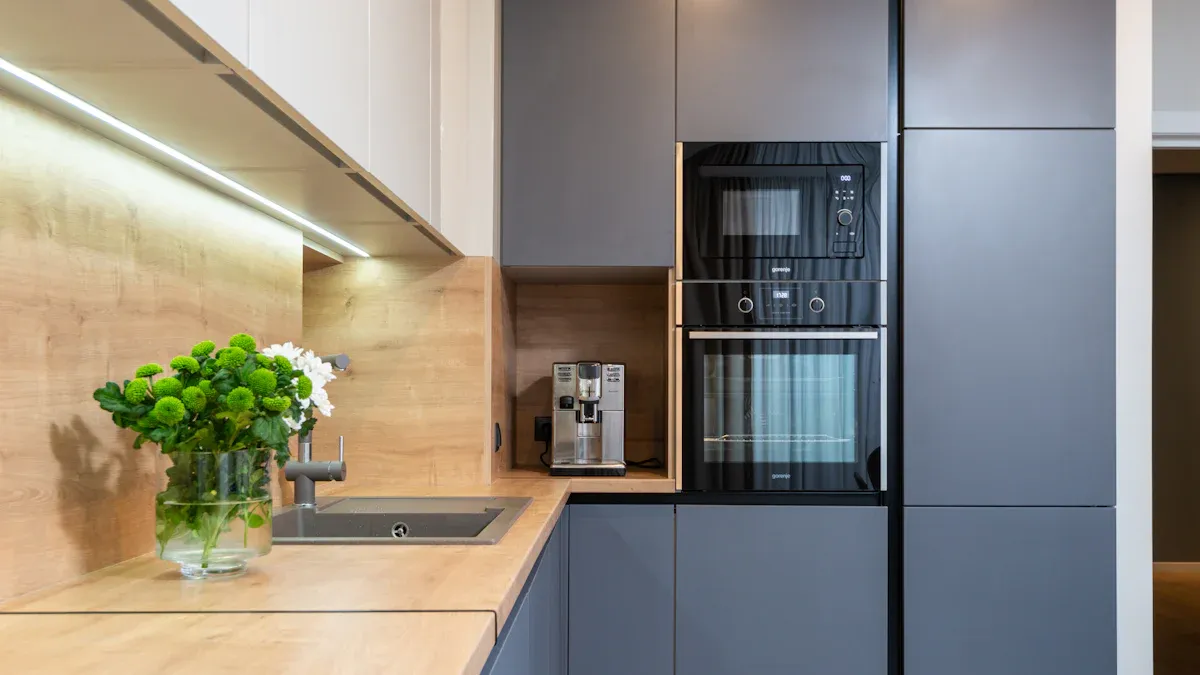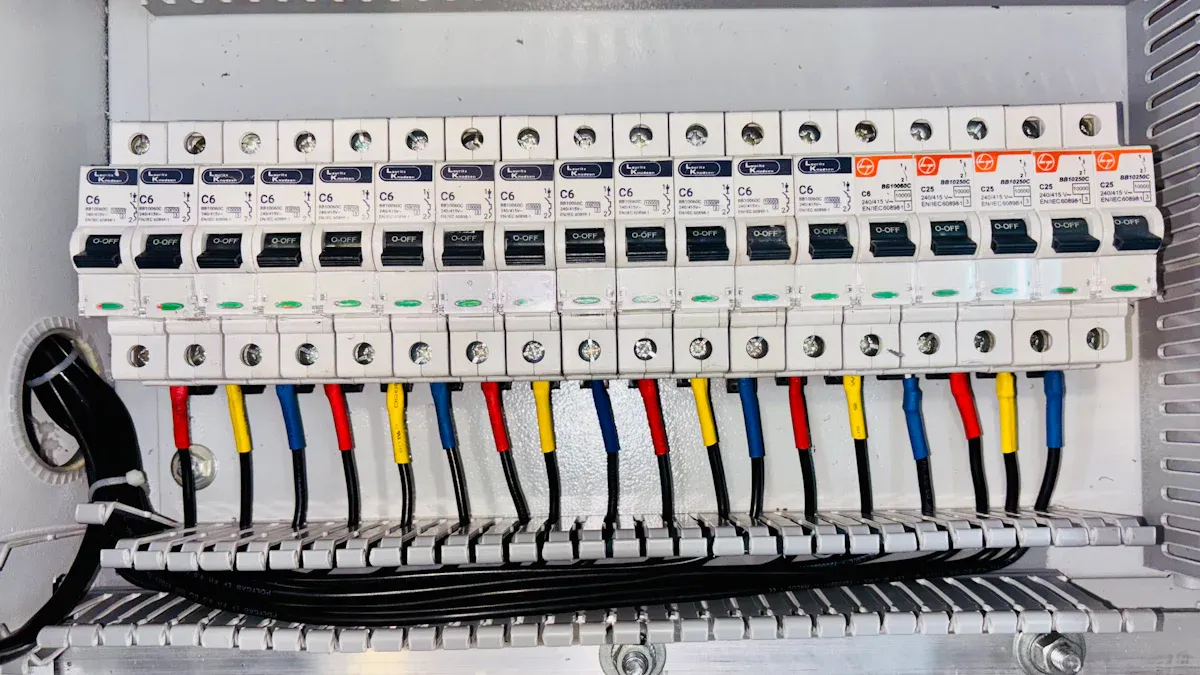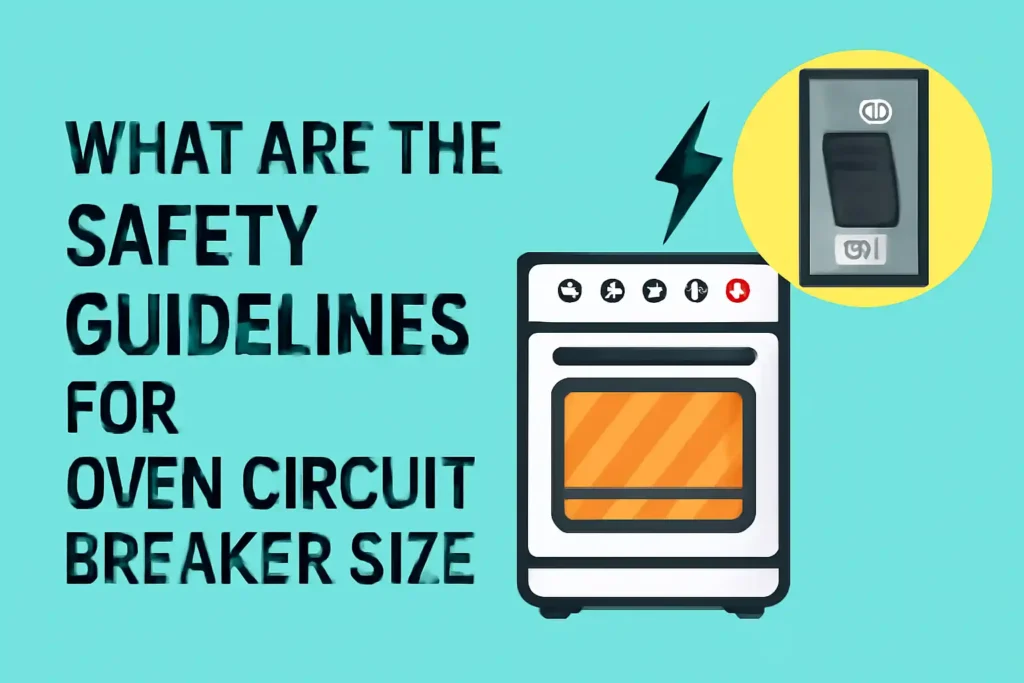You should use a circuit breaker size that matches your oven’s needs and follows the 125% safety rule. Most ovens use breakers rated at 20, 30, 40, or 50 amps, but always check the oven’s manual and local codes. Incorrect sizing can cause burning smells, hot breakers, or buzzing sounds at the panel. These signs may point to overheating or wiring problems. Using the right breaker protects your home and gives you peace of mind.
Key Takeaways
- Always choose a circuit breaker size that matches your oven’s power needs using the 125% safety rule to prevent overheating and fires.
- Check your oven’s manual and nameplate for the recommended breaker size and wire gauge before installation.
- Use the correct wire size that matches the breaker rating to keep wiring safe and avoid fire risks.
- Follow the National Electrical Code (NEC) and local codes, and get permits and inspections when required to ensure safe and legal installation.
- Call a licensed electrician for complex installs, code compliance, or if you feel unsure to protect your home and oven.
Oven Circuit Breaker Size

General Sizing Rule
You need to follow the 125% rule when choosing a circuit breaker size for your oven. This rule means you multiply the oven’s continuous load by 1.25 to find the right breaker rating. The National Electrical Code (NEC) requires this step to keep your wiring and breaker from overheating. For example, if your oven draws 16 amps, you multiply 16 by 1.25. The result is 20 amps, so you would use a 20-amp breaker. This extra margin helps protect your home from electrical fires and keeps your oven running safely.
Tip: Always round up to the next standard breaker size if your calculation falls between two ratings.
Common Amp Ratings
Most ovens use one of several standard breaker sizes. You will see 20, 30, 40, or 50-amp breakers in most homes. The right size depends on your oven’s power needs and what the manufacturer recommends.
- 20-amp breaker: Used for small wall ovens or compact models.
- 30-amp breaker: Common for single built-in ovens or standard electric ranges.
- 40-amp breaker: Needed for larger wall ovens or double ovens.
- 50-amp breaker: Required for heavy-duty or commercial-style ovens.
You should always check your oven’s manual and the nameplate for the recommended circuit breaker size. The NEC and most manufacturers list these sizes to match the oven’s maximum load.
Matching Wire Gauge
You must match the wire gauge to the circuit breaker size to prevent overheating and fire risks. The NEC provides clear guidelines for this. For example, a 20-amp breaker needs #12 AWG copper wire, while a 50-amp breaker needs #6 AWG copper wire. Using the correct wire size ensures your oven gets enough power and keeps your wiring safe.
Here is a quick reference table for common oven installations:
| Circuit Breaker Size (Amps) | Minimum Copper Wire Gauge (AWG) |
|---|---|
| 15 | 14 |
| 20 | 12 |
| 30 | 10 |
| 40 | 8 |
| 50 | 6 |
If you use a wire that is too small for the breaker, the wire can overheat and cause a fire. Always make sure the wire size meets or exceeds the breaker rating. This step is especially important for ovens, which often draw high currents for long periods.
How to Choose Breaker Size
Choosing the right circuit breaker size for your oven keeps your home safe and your appliance working well. You can follow a simple process to make sure you get it right.
Find Oven Amperage
Start by finding your oven’s power needs. Look for a label or metal plate on the oven. You can also check the user manual. The label will show the wattage (W) and voltage (V). Sometimes, it lists the amperage (A) directly. If you only see watts and volts, you can calculate the amperage.
Apply Sizing Formula
You can use a basic formula to find the right breaker size. Follow these steps:
- Write down the oven’s wattage and voltage.
- Divide the wattage by the voltage to get the amperage.
For example, if your oven uses 4,800 watts and 240 volts:
4,800 ÷ 240 = 20 amps - Multiply the amperage by 1.25 to add a safety margin.
20 amps × 1.25 = 25 amps - Round up to the next standard breaker size. In this case, use a 30-amp breaker.
- Check the National Electrical Code (NEC) to make sure your choice matches code rules.
Tip: Always round up to the next standard size. Never use a breaker smaller than your calculation.
Check Nameplate and Manual
Always check the oven’s nameplate and manual before you buy a breaker. Manufacturers often list the exact circuit breaker size you need. This information takes into account the oven’s design and safety needs. If you feel unsure, ask a licensed electrician to review your choice. This step helps you avoid mistakes and keeps your installation safe.
Code Requirements
NEC Guidelines
You must follow the National Electrical Code (NEC) when you install or replace an oven. The NEC sets the minimum safety standards for all electrical work in homes. For ovens and ranges, the NEC lists the required voltage and minimum circuit amp ratings. You can see these requirements in the table below:
| Appliance Type | Voltage Requirement | Minimum Circuit Amp Rating | Notes |
|---|---|---|---|
| Electric Range (typical) | 240/250 volts | 50 amps | Dedicated circuit required; use 6/3 NM cable or #6 THHN wire in conduit. |
| Electric Range (varied units) | 240/250 volts | 30 to 60 amps | Some units need as much as 60 amps or as little as 30 amps. |
| Cooktop and Wall Oven (separate) | 240/250 volts | Shared circuit allowed | Allowed if combined load does not exceed circuit capacity. |
The NEC also says you must use a dedicated circuit for most ovens. This means the oven has its own breaker and wiring. You should always check the oven’s manual to confirm the correct circuit breaker size.
Note: The NEC updates every three years. Always use the latest version for your project.
Local Codes
Your city or county may have extra rules for oven wiring. Local codes can be stricter than the NEC. Some areas require larger wires or special types of outlets. You should always check with your local building department before you start. They can tell you if you need a permit or if there are special rules for your area.
Permits and Inspections
Most places require a permit for new oven circuits or major electrical work. You need to apply for a permit before you begin. After you finish, an inspector will check your work. The inspector makes sure you followed the NEC and local codes. This step helps keep your home safe and up to code.
Tip: Permits and inspections protect you from costly mistakes and help prevent electrical fires.
Risks of Wrong Size

Overload and Fire
Choosing the wrong breaker for your oven can put your home at risk. If you use a breaker that is too large, it may not trip when the oven draws too much current. This can cause the wires to overheat. Overheated wires can melt their insulation and start a fire. You may notice a burning smell or see smoke near your oven or electrical panel. These are warning signs that you should never ignore.
Warning: If you ever smell burning or see scorch marks near your oven, turn off the power and call an electrician right away.
Nuisance Tripping
A breaker that is too small for your oven will trip often. This is called nuisance tripping. You may find your oven shuts off in the middle of cooking. This can ruin your food and cause frustration. Frequent tripping also puts extra wear on the breaker. Over time, the breaker may become less reliable. You should always match the breaker to your oven’s needs to avoid these problems.
Here is what can happen with the wrong breaker:
- Oven shuts off during use
- Breaker trips even with normal cooking
- You need to reset the breaker often
Appliance Damage
Using the wrong breaker can also harm your oven. If the breaker does not protect the wiring, your oven may get too much current. This can damage the oven’s internal parts. You may face costly repairs or need to replace the oven sooner than expected. Some ovens have sensitive electronics that can fail if the power supply is not stable. Protecting your oven starts with the right breaker.
Tip: Always check your oven’s manual for the correct breaker size. This helps you avoid damage and keeps your oven working longer.
When to Call a Pro
Complex Installs
Some oven installations go beyond basic wiring. You might face extra steps if your oven needs a dedicated circuit, advanced wiring, or special features. These situations often require more skill than a typical DIY project. You should call a licensed electrician if you see any of these signs:
- The oven manual asks for a dedicated circuit or special wiring.
- You need to upgrade your electrical panel.
- The wiring in your home looks old or damaged.
- You feel unsure about any step in the process.
Professional guidelines say that licensed electricians know how to follow safety standards and electrical codes like the National Electrical Code (NEC). Electricians have the training to handle complex wiring and advanced setups. They also keep up with changing codes and offer warranties for their work. This protects your home from risks like electrical fires or shocks.
Tip: If you ever feel unsure about the wiring or instructions, it is safer to call a pro.
Code Compliance
Electrical codes help keep your home safe. You must follow both the NEC and your local building codes when installing an oven. These rules can change over time and may be different in each city or county. Licensed electricians know the latest codes and make sure your installation passes inspection.
You should call a professional if:
- You need a permit for your project.
- Local codes require special outlets or wiring.
- You want to make sure your work will pass inspection.
Electricians also carry liability insurance. This means you get extra protection if something goes wrong. You can trust that your oven will work safely and meet all code requirements.
Note: Always check with your local building department before starting any electrical work.
You protect your home and oven when you choose the right breaker. Experts highlight that circuits should only carry up to 80% of their rated load to prevent overheating and electrical hazards. Always follow the manufacturer’s instructions and local codes. If you feel unsure or face a complex job, contact a licensed electrician. Safety and code compliance keep your kitchen running smoothly and help prevent electrical fires.
FAQ
What happens if you use the wrong size breaker for your oven?
If you use the wrong size breaker, you risk fire, damage to your oven, or frequent power trips. Always match the breaker to your oven’s needs for safety.
What wire size should you use with a 40-amp oven breaker?
You should use #8 AWG copper wire for a 40-amp breaker. This wire size handles the current safely and meets code requirements.
What does the 125% rule mean for oven breakers?
The 125% rule means you multiply your oven’s running amps by 1.25. This helps you choose a breaker that can handle the oven’s load safely.
What should you check before installing a new oven breaker?
Check your oven’s manual, the nameplate, and local electrical codes. You should also confirm the correct wire size and breaker rating before starting.
What signs show your oven breaker may be unsafe?
Look for burning smells, hot breakers, or buzzing sounds. These signs mean you should turn off power and call an electrician right away.
The following information may be of interest to you
What happens when using circuit breakers with higher current?
How to choose the appropriate size of circuit breaker
Manual or Automatic? Decide on Your 200 Amp Transfer Switch
Can I replace a 15 amp breaker with a 20 amp?


KC3-H-2-Pole-Breaker-Mini.webp)

